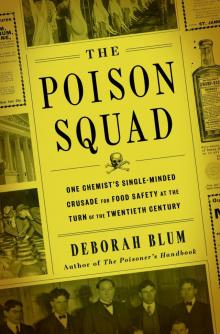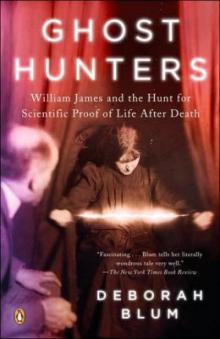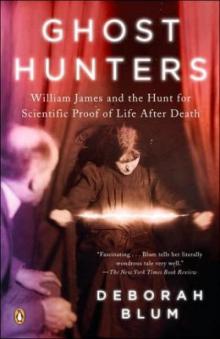- Home
- Deborah Blum
Angel Killer Page 3
Angel Killer Read online
Page 3
M’Naghten, who had complained loudly of persecution by imaginary spies, was acquitted in an insanity verdict. The rule based on his name was inspired by a public outcry against such perceived leniency. It added some legal clarity to the matter, spelling out a basic standard of criminal lunacy: “At the time of the committing of the act, the party accused was laboring under such a defect of reason, from disease of the mind, as to not know the nature and quality of the act he was doing or if he did know it, that he did not know he was doing what was wrong.” And it made clear that the burden of proving insanity rested with the defense.
Whether Albert Fish had killed while in the kind of mental fugue that met this legal standard was the central question of his murder trial. There was, after all, no question that he’d kidnapped, murdered and eaten Grace Budd—he’d signed six confessions to that effect while in jail. But these acts in and of themselves didn’t necessarily reach the standard of the M’Naghten rule. For that, Dempsey had to show that Fish had no sense of the moral wrongness of his actions at the time.
In Fish’s confessions and correspondence, prosecutors thought they’d found evidence to counter that. In his letter to King, for instance, Fish had talked about his “wrongs” catching up with him, an obvious indication that he knew the moral weight of his deeds. The defense in turn argued that the way Fish defined “wrong” was in itself insane. “His test,” Wertham would explain later, “was that if it had been wrong he would have been stopped, as Abraham was stopped, by an angel.”
For Wertham, proving Fish legally insane mattered for reasons reaching far beyond the courtroom in White Plains. Having encountered the poor and otherwise marginalized often in his work, the profile of the typical victims of killers like Fish and Haarmann was not lost on him: They were usually culled from the most unlucky and vulnerable corners of society—the urban poor, minorities, and orphans who were least likely to be missed. If behavior of the sort that Fish had exhibited in the years before his capture could be established as grounds for commitment and treatment, then alienists like Wertham could do real good—they could study and learn how to treat these killers, and thus learn how to protect society from its most deeply troubled members.
Where Wertham saw an opportunity, however, Westchester County Chief Assistant District Attorney Elbert T. Gallagher saw only weakness. To Gallagher, Fish was simply a stranger killer who needed to be stopped, a murderer who would only set down his knives when he was dead. Fish’s attorney might call him insane, but Gallagher wasn’t fooled. He knew evil when it stood in front of him. And he meant to see to it that Fish went not to the asylum, but to the electric chair.
Nine
It was the Gray Man whom Gallagher evoked as he opened the proceedings for the prosecution—the false grandfather who calculated his killings, who knew when to step out of the light and into the sheltering shadows. There was too much cunning in these crimes, Gallagher said, for some hapless lunatic to have carried them out. The killer had used a fake name and invented a story to trick Grace Budd’s parents. He had found an empty house, a safely isolated place where he could take the child. “Don’t put any stock, gentlemen, in this divine-command business,” Gallagher told the jury.
Gallagher had brought a cardboard carton with him to the courthouse. It contained Grace’s splintered bones, and he shook it—the dry rattling reminder of a dead child—to drive home his argument. The nonsense about angels and Christ and the echoing voices in an empty room: That was “merely a smokescreen,” a cover-up, he told the jury. There was no madness here. There was only cold and deliberate method.
To underscore this point, Gallagher paraded four alienists through the witness stand to testify that the accused, while perhaps a little strange, knew perfectly well what he was doing. Foremost among them was Menas Gregory, who, given his past history with this particular killer, could hardly have been expected to say otherwise.
Gregory was the former director of the psychiatric ward at New York’s venerable Bellevue Hospital. The old brick building overflowed with inmates, from the criminal to the suicidal to the merely peculiar. Amid the throng, nobody, Gregory included, had taken any particular notice of one Albert Fish, who was admitted into the ward, observed, and released—diagnosed as abnormal but harmless, troubled but sane.
Fish went to Bellevue on December 15, 1930—less than two years after the murder of Grace Budd. It was a court-ordered evaluation, requested by his daughter, who’d reported that he was showing signs of mental disturbance. Gregory oversaw the evaluation at Bellevue, where Fish stayed under observation for a month. He reportedly startled the nurses by climbing into the bathtub to pray. But, as Gregory admitted during the trial, he and his staff did not spend much time exploring the old man’s religious compulsions. The alienists decided he was definitely off—“psychopathic personality; sexual type”—but sane and safe to set free.
In the summer of 1931, Fish was back in a psychiatric unit, this time at Kings County Hospital, following an arrest. During the previous years—as the police would later realize to their chagrin—he’d been picked up several times on minor grifting charges ranging from embezzlement to theft. The latest arrest followed a complaint about sending obscene letters. When the police arrived at the hotel where Fish then worked for room and board, they found a homemade cat-o’-nine-tails in his room. As the arresting officer later explained, there was just something about the man—he looked so “very, very weird” at the moment of discovery.
The police sent Fish to the hospital, where he stayed for two apparently uneventful weeks. Not once was he asked about the cat-o’-nine tails, though he’d admitted to police that he liked to whip himself with it. None of that appeared in the hospital report. He was “quiet,” the clinic noted: a “cooperative, oriented” old man who, his caretakers concluded a second time, posed no danger to anyone. Not only had Fish—at a time when he’d already proved himself a cannibal killer—been declared a low-risk patient, but he was also now a suspect in at least four child killings that had occurred after his release from the hospitals.
From his seat in the witness stand, Gregory was rigidly defensive about Bellevue’s handling of Fish. His determination to admit no mistake on behalf of himself or his hospital rang through his testimony, sometimes ludicrously. “Do you call a man who drinks urine and eats human excretion sane or insane?” Dempsey asked him during his cross-examination.
“Well, we don’t call them mentally sick,” Gregory replied.
“That man is perfectly all right?”
“Not perfectly all right. But he is socially perfectly all right.”
Dempsey marveled at how little evidence the Bellevue reports contained of time spent with the patient or analysis of him and demanded to know how this could qualify as enough to determine Fish’s sanity. “Since he is not an insane person, the record is not voluminous,” Gregory replied.
“But is there anything about his family background?” snapped the lawyer.
“I can’t find anything here,” Gregory replied, leafing through the papers.
“When do you make a careful inquiry?” Dempsey inquired.
Only when he saw signs of insanity, Gregory replied. Bellevue had to evaluate some 50 patients a day. Its harried staff didn’t have time for careful evaluation of those, like Albert Fish, who showed only average mental stress. “The city does not provide sufficient help to make a complete examination in every case,” he said.
It was a theme picked up by the other state witnesses. One prosecution expert, Dr. Charles Lambert, assured the jury that although Fish had undoubtedly assaulted hundreds of children, and although he definitely had “a psychopathic personality,” he was not actually suffering from any psychosis.
“Doctor,” Dempsey said, “assume that this man not only killed this girl but took her flesh to eat it. Will you state that that man could for nine days eat that flesh and still not have a psychosis and not have any mental diseases?”
“There is no accounting for t
aste,” Lambert said.
Ten
As the trial entered its second week, the jury gave nicknames to the two attorneys battling over Fish’s fate. They called Gallagher “Bones,” for his habit of shaking that ghastly cardboard carton. They nicknamed Dempsey “I-Object,” because of his perpetual outrage, his jack-in-the-box propensity to leap up to challenge the psychiatric testimony.
But protest alone wasn’t enough to prevail. Dempsey’s witnesses had to be better. They had to compel understanding and, perhaps, even forgiveness for a man who had done so many unforgivable things.
Wertham took the stand first. He did not try to paint a pretty picture of Fish. “This man has roamed around in basements and cellars for 50 years,” he said. “There were so many innumerable instances that I can’t begin to give you how many there are. But I believe to the best of my knowledge that he has raped 100 children. At least.”
And of course there were the murders. The police were still trying to tally the victims. But it seemed, Wertham said, that in his mind his longtime obsession with pain had become entwined with religion. He saw angels, heard saints like John the Baptist giving him orders, listened as their voices translated the teachings of the Bible into blood. He heard instructions to beat and torture: “Blessed is the man who correcteth his son.” And when he drank Grace Budd’s blood and ate her flesh, Wertham said, to him it was something sacred, “associated with the idea of Holy Communion.”
Wertham’s analysis was echoed by the other two alienists called by Dempsey, both well-respected practitioners: Dr. Smith Ely Jelliffe, former president of the New York Psychiatric Association, and Dr. Henry A. Riley, a professor of neurology at the Columbia University College of Physicians and Surgeons. All three had been struck by the force and power of Fish’s religious delusions. His interactions with his angels were so influential, Jelliffe testified, that the “whole killing of the Budd girl took on the character of a religious ritual.” He talked to a Christ he thought he could see dripping with blood, Riley said. And Christ told him that he needed to protect the girl from “becoming a harlot.” Her death, Riley said, was essentially a virgin sacrifice.
Fish had no rules or sense of right and wrong grounded in anything other than craziness, the alienists argued. He’d been an unbalanced child, deformed sexually by his brutal orphanage experiences. He had a moral compass, but one that rested on hallucinations of vengeful angels, Biblical teachings warped beyond recognition. However that compass spun, it moved in a way that was completely detached from the mores of society—and reality. To a man, all three psychiatrists agreed that here was a deviant, terrible killer—and a man who met every criterion of legal insanity.
“Every maniac, every insane person plans and connives,” Dempsey told the jury. “Every animal, gentlemen, plans and connives. … The fact that a man can connive and plan an outrageous, dastardly, fiendish crime like this is no indication of the fact that a man is in his right mind.” The legal standard of sanity demanded a clear awareness of right and wrong; a man waiting on the dispensation of vengeful angels had no hope of such clarity. “Do you believe before God that Albert Fish was sane on June 3, 1928? Do you believe on that day he knew the distinction between right and wrong? Unless you believe that, gentlemen, if you later find him guilty, it will be on mere breath, not upon evidence.”
By this point in the trial, Fish—whom Dempsey had decided to keep off the stand—looked less like a vampire than like the victim of one. Huddled in his baggy suit, he had grown paler and more transparent by the day. He looked, one journalist wrote, like “a corpse insecurely propped in a chair.” But by the end of Dempsey’s closing arguments, on the morning of March 22, he was in tears.
Gallagher was second to make his closing argument before the jury, and he began by mocking Dempsey’s portrait of Fish, helpless in the grip of his madness. Instead, he called on the jury to “remember the defenseless little innocent Grace Budd,” dying at the hands of a villain of supernatural proportions in a strange and lonely place, calling for her mother.
The criticisms of Bellevue were just a distraction, Gallagher insisted, the tales of divine commandments only more of the same. Dempsey was right to bring up the idea of planning and conniving—because that was just what Fish had done in the kidnapping and murder of this child. From his use of a fake name to his choice of isolated Wisteria Cottage, he had plotted this crime. Gallagher was willing to concede that the old man had sexual abnormalities, but none of them rose to the level of guilt-absolving insanity.
Grace had died in a premeditated crime, a kidnap and murder in the interests of sexual gratification. And the man who planned it did not deserve to live out his days in an asylum. “Do the right thing,” Gallagher concluded, calling on the jury to send Fish where he belonged: the electric chair at Sing Sing Prison.
Eleven
Even the jaded crime reporters at the trial found themselves wrestling with the question of what exactly that right thing was in Fish’s case. They took a vote and found themselves agreed that Fish was legally insane. That afternoon, after the closing arguments, the judge sent the alternate juror home; he, too, told the reporters that he thought Fish was insane.
The 12 remaining men were sent to deliberate at 3 p.m. on Friday, March 22. They broke briefly for dinner at a nearby hotel and then returned to the jury room. At 8:27 p.m. they entered the courtroom, unsmiling, to read the verdict. Fish was guilty of the charges of kidnapping and first-degree murder. In subsequent interviews, the jurors would admit that, like the reporters, they believed Fish to be off-the-charts crazy. But they couldn’t bring themselves to send this kind of killer to a merciful end in an asylum.
Fish sat quietly in his chair as reporters stampeded out of the room in search of telephones. He’d always been good at projecting the image of his choice. His response to the verdict, after the initial jolt, was pallid indifference. He wasn’t afraid of pain, he said; this would be a new way of experiencing it. “I have no particular desire to live,” he had told Wertham.
But if Fish had publicly lost interest in the fight, his champions had not. The proceedings, the shoddy expert testimony, had offended Dempsey’s sense of human decency. He appealed the conviction to New York governor Herbert Lehman, and when he went to meet with him in Albany he brought with him the equally outraged Wertham. In their judgment, Dempsey argued to Lehman, the jury had acted out of fear, not dispassionate justice. It was similar to the superstitious horror of the infamous Salem witch trials, he said. Fish’s conviction “proves merely that we still burn witches in America.”
Wertham, who was accustomed to dealing with the lower reaches of government—public-health bureaucrats, policemen, prison guards—had never before spoken to so lofty an official as Lehman. Going into the meeting, he had in his mind the image of the emperors and kings of old, with whose prerogative the idea of acquitting the insane had originated—the kind of ruler who “had to sit in his capacity as a human being, using his personal judgment to listen and decide,” he later wrote.
“It is not as an expert that I am appealing to you,” he told Lehman, according to his account in The Show of Violence, “because if you had all the facts assembled, including the other murders committed by this defendant, and their circumstances, you would not need an expert. I am not appealing to you for clemency. I am appealing to you as a statesman. In this case all the hairsplitting about legal definitions was just a covering up of a social default. I am asking you to commute the death sentence to lifelong detention in an institution for the criminal insane—and to make this case an example and a starting point for a real scrutiny not of individuals nor individual institutions, but of the whole haphazard and bureaucratic chaos of the psychiatric prevention of violent crimes.”
As he spoke, Wertham glanced at the governor’s counsel, who was sitting beside Lehman; the man nodded, smiling, even, at the alienist’s argument. But Lehman himself sat expressionless. He had no interest in commuting the death sentence of a sexually devian
t, cannibalistic child killer. As Wertham recalled the meeting, it was easy enough to tell that they’d lost. The governor looked down at his desk, at the papers outlining Fish’s murderous history. And throughout the meeting, Lehman’s face remained as cold and blank as a stone wall.
The Gray Man went to the Sing Sing electric chair on January 16, 1936. There were those who thought he’d finally fulfilled his destiny, faded completely away into the dust. He walked quietly to the platform where the black chair stood and sat patiently in the apparatus as the executioner buckled the straps and fitted the helmet over his head. “Do you have any last words?” the executioner asked. “I don’t even know why I’m here,” Fish replied softly.
But Fish had also written Dempsey one last letter, a statement that he wanted read as a final farewell. The attorney called the reporters gathered at the prison to describe it. “I will never show it to anyone,” he said. “It was the most filthy string of obscenities that I ever read.” He locked them away, all those pages bubbling with the rage that the killer had kept carefully hidden, even to the end.
Dempsey never did share the letter. But there were days when he could still hear its words, the last echo of a madman’s voice. It drifted like smoke in the air, then blew away.
Epilogue
Two years after Fish’s execution, the famed psychoanalyst Gregory Zilboorg—therapist to the writer Lillian Hellman, the composer George Gershwin, and the playwright Moss Hart, among others—brought up the killer’s trial in a talk before the New York Neurological Society. By then, the trial and the ethical questions that shadowed it had prompted some serious soul-searching in the psychiatric community. In his speech, titled “Misconceptions of Legal Insanity,” Zilboorg noted the shoddy behavior of many of his colleagues who had testified for the prosecution in the trial. The problem, he argued, was that the psychiatrists had allowed society’s instinct to execute its worst killers cloud their professional judgment of mental illness.

 Love at Goon Park: Harry Harlow and the Science of Affection
Love at Goon Park: Harry Harlow and the Science of Affection The Poison Squad
The Poison Squad Ghost Hunters: The Victorians and the Hunt for Proof of Life After Death
Ghost Hunters: The Victorians and the Hunt for Proof of Life After Death The Poisoner's Handbook
The Poisoner's Handbook Angel Killer
Angel Killer The Best American Science and Nature Writing 2014
The Best American Science and Nature Writing 2014 The Ghost Hunters
The Ghost Hunters Love at Goon Park
Love at Goon Park